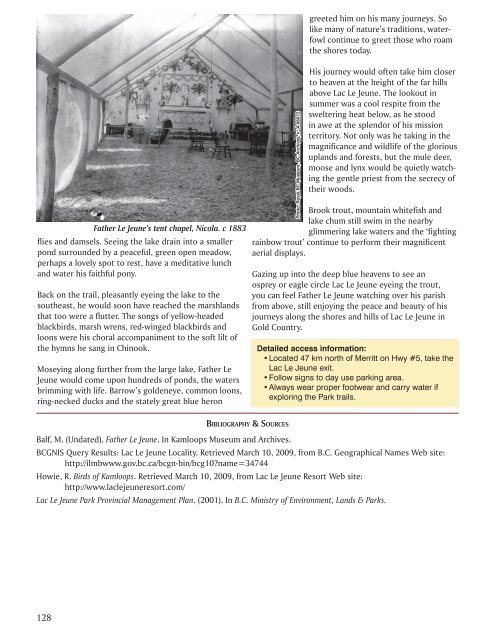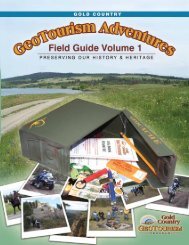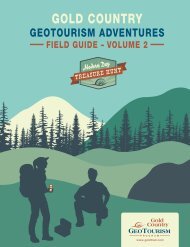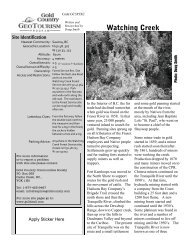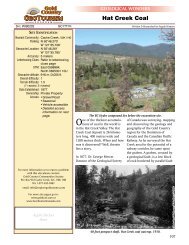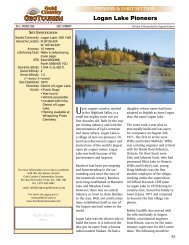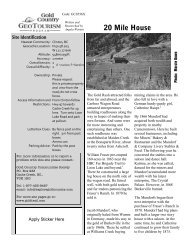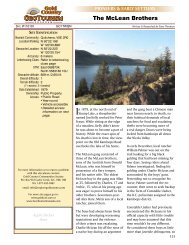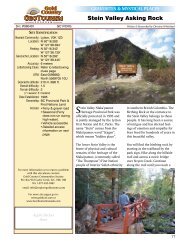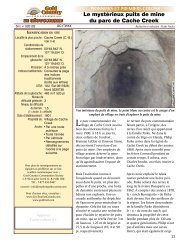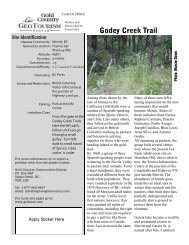E book Field Guide.indd - Gold Country
E book Field Guide.indd - Gold Country
E book Field Guide.indd - Gold Country
Create successful ePaper yourself
Turn your PDF publications into a flip-book with our unique Google optimized e-Paper software.
greeted him on his many journeys. So<br />
like many of nature’s traditions, waterfowl<br />
continue to greet those who roam<br />
the shores today.<br />
Father Le Jeune’s tent chapel, Nicola. c 1883<br />
flies and damsels. Seeing the lake drain into a smaller<br />
pond surrounded by a peaceful, green open meadow,<br />
perhaps a lovely spot to rest, have a meditative lunch<br />
and water his faithful pony.<br />
Back on the trail, pleasantly eyeing the lake to the<br />
southeast, he would soon have reached the marshlands<br />
that too were a flutter. The songs of yellow-headed<br />
blackbirds, marsh wrens, red-winged blackbirds and<br />
loons were his choral accompaniment to the soft lilt of<br />
the hymns he sang in Chinook.<br />
Moseying along further from the large lake, Father Le<br />
Jeune would come upon hundreds of ponds, the waters<br />
brimming with life. Barrow’s goldeneye, common loons,<br />
ring-necked ducks and the stately great blue heron<br />
Photo: Royal BC Museum, BC Archives, n o A-06072<br />
His journey would often take him closer<br />
to heaven at the height of the far hills<br />
above Lac Le Jeune. The lookout in<br />
summer was a cool respite from the<br />
sweltering heat below, as he stood<br />
in awe at the splendor of his mission<br />
territory. Not only was he taking in the<br />
magnificance and wildlife of the glorious<br />
uplands and forests, but the mule deer,<br />
moose and lynx would be quietly watching<br />
the gentle priest from the secrecy of<br />
their woods.<br />
Brook trout, mountain whitefish and<br />
lake chum still swim in the nearby<br />
glimmering lake waters and the ‘fighting<br />
rainbow trout’ continue to perform their magnificent<br />
aerial displays.<br />
Gazing up into the deep blue heavens to see an<br />
osprey or eagle circle Lac Le Jeune eyeing the trout,<br />
you can feel Father Le Jeune watching over his parish<br />
from above, still enjoying the peace and beauty of his<br />
journeys along the shores and hills of Lac Le Jeune in<br />
<strong>Gold</strong> <strong>Country</strong>.<br />
Detailed access information:<br />
• Located 47 km north of Merritt on Hwy #5, take the<br />
Lac Le Jeune exit.<br />
• Follow signs to day use parking area.<br />
• Always wear proper footwear and carry water if<br />
exploring the Park trails.<br />
BIBLIOGRAPHY & SOURCES<br />
Balf, M. (Undated). Father Le Jeune. In Kamloops Museum and Archives.<br />
BCGNIS Query Results: Lac Le Jeune Locality. Retrieved March 10, 2009, from B.C. Geographical Names Web site:<br />
http://ilmbwww.gov.bc.ca/bcgn-bin/bcg10?name=34744<br />
Howie, R. Birds of Kamloops. Retrieved March 10, 2009, from Lac Le Jeune Resort Web site:<br />
http://www.laclejeuneresort.com/<br />
Lac Le Jeune Park Provincial Management Plan. (2001). In B.C. Ministry of Environment, Lands & Parks.<br />
128


